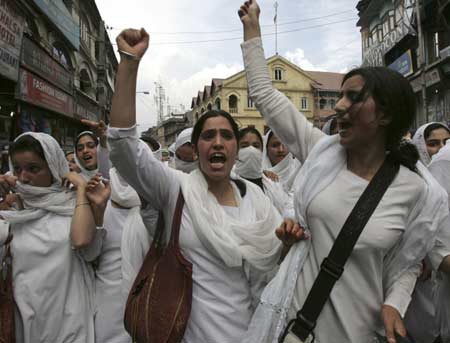
By Izhar Nazir Ali, Kashmir reader
Published: Sun, 06 January 2013
Pattan: It was a chilly January morning. Flakes of snow had just started descending from the overcast sky. Like every day, Ali Mohammad, then 52, moved his coach to ferry passengers. By the time the bus reached near Sopore town, and Mohammad lifted his foot from the accelerator, it had turned into a mobile mortuary. Glass pieces spread over the floor, seats drenched in blood, bodies piled up. Fifteen dead and many injured. Mohammad was the only survivor in the ill-fated bus as the tragic day in the bloody history of Kashmir came to be known as the Sopore massacre of January 6, 1993. At least 45 unarmed civilians were killed in cold blood—many reports put the toll at 54—and about 350 shops set ablaze by paramilitary BSF men to avenge the killing of two of their colleagues by militants earlier in the day.
Twenty years after the event, Mohammad says the “carnage will haunt me till death. Many years have passed but I can still hear the screams of innocent people. I remember the face of a former bus conductor who was talking to me before he was shot dead. I can’t forget another youth who was gunned down outside the cinema when he ran for his life. I can’t forget how people entered the shops to save their lives but were charred alive,” 72-year-old Mohammad told Kashmir Reader at his modest single storey house in north Kashmir’s Pattan town.
Narrating the events of the day that saw Valley exploding with anger, Mohammad, who was then a driver with government-run State Road Transport Corporation, said: “Around 11 am that day, as usual I moved the coach (JKY/1901) from bus stand to Bandipore district. With dozens of passengers onboard, I had to abruptly stop the vehicle on reaching the town square. The people were running. No one knew what was going on. In the meantime, a BSF party carrying an injured trooper passed by.”
“Boondh daalo saalon ko (kill all these…),” the officer leading the party, Mohammad said, ordered his men. “We were silently watching troopers firing in all directions. Suddenly karakulli cap of my friend Abdur Rashid, the former conductor, fell down. I bowed to pick it up. In the meantime, a bullet smashed the front window of the bus. I got up and saw Rashid dead. Within seconds, two BSF men boarded the bus from the front and the rear doors and started firing indiscriminately at the passengers. The cries for mercy and screams of the civilians went unheard in the bursts of gunfire.”
As the guns were booming, Mohammad says, he quickly jumped out from the driver’s door and crawled to take shelter in the nearby Samad Talkies, an erstwhile cinema. Outside, he said, two BSF men were firing on the civilians “as if the victims were flies.”
“A young boy ran in front of me. He too was shot dead by the troopers. I don’t know how I survived. I don’t know why BSF men didn’t notice me while I was running towards the cinema.”
Mohammad’s belief that the cinema was a safe place was proven wrong. “Scores of men, women and children who had taken refuge inside the hall were crying for help after the cinema was set on fire by the troopers. The flames dashed hopes of our survival. We just gave up. We thought our end was near. Suddenly, I noticed there was a window in the rear that led to a graveyard. We smashed the window and ran to save our lives.”
When the dust settled, Mohammad says he revisited the spot in the evening to retrieve his vehicle. “When I boarded the bus, I saw glass spread all over. Blood drenched seats. It was a horrible scene. I just fled away leaving the vehicle there.”
After the massacre, Mohammad says, he boarded a Srinagar-bound bus that was coming from the frontier Kupwara district. On reaching near Sopore bridge, the BSF men, he says dragged the passengers from bus and thrashed them savagely.
“They didn’t spare anyone. They thrashed men, women and children with batons and rifle butts. They were angry over the death of their colleague. However, for them the slaughter of 54 civilians didn’t matter at all,” he adds.
Back home, Mohammad’s village was in mourning as news had spread about his death in the massacre. “My name had figured in the list of martyrs. My colleagues and officials had thought I was dead. They even visited my house to offer condolences to my family,” he says.
“Incidentally, a man had died in my village. My colleagues and officials came and offered prayers at his grave presuming it to be mine,” he adds with a smile.
Mohammad says the events of January 6,’93 left an “indelible mark on my heart and mind.”
“Since then, I haven’t visited Sopore. I don’t drive anymore. I shouldn’t be alive. I survived thrice on that day. Some divine help saved me from the clutches of death,” he add
Related articles
- #Rape by man in uniform (BSF), abandoned, No action taken neither by BSF nor by police #Vaw (kractivist.wordpress.com)
- A Review Of Human Rights In Jammu & Kashmir In 2012: JKCCS (kashmirsolidaritymumbai.wordpress.com)









[…] #Soporemassacre- Twenty years on ,Jan 6, 1993: ‘I saw BSF men killing civilians like fliesR… (kashmirsolidaritymumbai.wordpress.com) […]
[…] #Soporemassacre- Twenty years on ,Jan 6, 1993: ‘I saw BSF men killing civilians like fliesR… (kashmirsolidaritymumbai.wordpress.com) […]
[…] #Soporemassacre- Twenty years on ,Jan 6, 1993: ‘I saw BSF men killing civilians like fliesR… (kashmirsolidaritymumbai.wordpress.com) […]